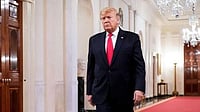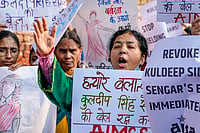After two alien and ferocious forces—called ‘open skies’ and competition—were unleashed in the aviation sector, the Indian-AI merger was seen by politicians as critical for the profitable survival of the two airlines. Patel admits that the two were unable to adapt to a market that was "changing at dizzying speed" and that the need to rationalise their assets and infrastructure was ‘logical’. Fortunately, the move has the blessings of the Left parties and CPI(M)’s Nilotpal Basu feels that "it’s an important business movement, especially in the wake of the (recent) Jet-Sahara merger."
That’s probably because Patel has given two assurances to the Left leaders: one, that both airlines will continue to be present in their specific markets—Indian largely in the domestic segment and AI in global one—and, two, the merger will be completed "without raising the spectre of downsizing" of the existing combined employee strength of 35,000. So, what’s the excitement all about? What are the immediate benefits of the planned Indian-AI entity?
Achieving operational efficiencies, leading to huge cuts in costs, seems to be the overriding objective of Patel’s decision. For instance, AI will not have to service domestic routes, as it does today to connect international passengers to several domestic destinations. The Indian fleet, idle during the nights when AI flights land in India, can be used to ply domestic routes. In addition, the Indian planes can also act as interlinking ones to ferry AI’s passengers straight to their domestic destinations without having to commute between airports. "The Indian’s A-320 is an excellent choice for this purpose as one needs wide-bodied planes to accommodate the huge cargo that global travellers carry," feels a Mumbai-based source who’s close to AI.
Using Indian’s fleet for domestic routes will enable AI to use half of the bilaterals that it’s not able to use because of fleet shortage. (Bilaterals are agreements signed between two countries where each is allowed to fly more routes on a reciprocal basis.) Add to this the cost savings if Indian and AI can have common engineering facilities, reservation systems, maintenance and repair division and training facilities. But don’t expect tickets to become cheaper. That will happen only when the new company is in a position to pass on the benefits of cost saving to customers which, according to Jayesh Desai, national director (transaction advisory services), Ernst & Young, "is a long way off from now."
On the financial front, a bigger and a single national carrier will help. Together, the two airlines plan to raise Rs 44,000 crore in debt over the next few years. The emergence of a larger airline, with combined revenues of nearly Rs 14,000 crore, will go a long way in improving credit worthiness, credit rating and solvency criterion while raising the money. It’ll also enable them to use each other’s cash reserves efficiently; previous attempts at doing this had failed miserably.
While these are the immediate reasons, there are a few long- and medium-term implications. Globally, the new airline will attain a critical mass, as has happened in the case of global mergers like the one betweenKLM and Air France. Indian-AI can then enter into global partnerships like the Star Alliance, which allows an integration of frequent flyer programmes for several airlines, allows premium customers access to multiple facilities, and helps them travel in a seamless manner across member airlines. "It will help an entry into this alliance, which plays hard ball while evaluating new members," says Satish Jain, senior VP, JM Morgan Stanley.
Domestically, explains Desai, "Patel wants to put an evolutionary cycle in place where one will see two-three large players acting as the main stabilisers in the Indian market. The proposed merger reflects not only the minister’s vision of the macro-market, but is an intelligent move to minimise and control costs." Adds Shekhar Das, senior aviation consultant, Frost and Sullivan, "It aims at leveraging the scope and scale of the two airlines which will help when the merged airline launches its ipo."
Competitors and critics are, however, unsure whether the stated synergies can be achieved. For example, G.R. Gopinath, MD, Air Deccan, feels that size is no panacea for success. "Companies that become too big lose their differentiator and oscillate between surviving or going under, as happened in the case of GM Motors. In the case ofPSUs like Indian and Air India, there’s no guarantee that the next government will have a change of heart and demerge them," he explains. He adds that Indian already has the requisite scale and, despite being subsidised for flying to areas like the Northeast, it continues to incur losses.
A few private airlines contend that if the issue of monopoly cropped up in the case of the Jet Airways’ acquisition of Air Sahara—and the MRTPC is investigating it—then the same can be said about the Indian-AI combine. Together, the latter will fly a majority of the domestic and international routes and be in a position to kill competition. (It’s a different matter that low-budget airlines like Air Deccan aren’t scared. Gopinath says his airline is competing with trains and he can always get new passengers, even if the existing ones graduate to travelling on Jet-Sahara or Indian-AI.)
Others feel that the synergies will not materialise immediately. Says a Mumbai-based aviation source, "Route rationalisation, integration of flight schedules, and efficient use of manpower, where there will be a struggle for supremacy between the employees of the two airlines and also to grab goodies like foreign travel allowance, are issues that will need to be ironed out. But the sheer capacity that can be released makes it worth the effort." It’s easier said than done. Imagine the lobbying that will happen while the ministry is deciding the composition of the new management or the newCMD of the combined entity. Or, what will be the new logo, branding and image of the new Indian-AI?
But it’s at the policy level that changes will need to be made before the merger of the two state carriers can go through. For example, the ministry needs to come out with clear-cut regulations on M&As (see box on page 52). At present, a merger or a takeover doesn’t ensure an automatic transfer of infrastructure rights like airport parking bays and slots. Which is one of the reasons why Jet Airways had lost interest in its bid to buy Air Sahara. Things changed only after, according to agency reports, the government cleared the transfer of all of Sahara’s assets, including parking bays and slots, to Jet. But, in future, if a new policy isn’t in place, there’ll be several other issues that are likely to create roadblocks during the process of merging the two state carriers.
At the moment, the two virtually monopolise airport infrastructure. To add to that, a number of private players have entered the market leading to a crisis situation, where the existing infrastructure can’t cope up with the demand. Air Deccan’s Gopinath cribs that "India is facing an acute crisis where there are no hangars available. I have a damaged Airbus and no place to park it. I am still waiting to hear from Indian whether they will rent me one."
A visit to either the Delhi or the Mumbai airport at peak hours (mornings and evenings) makes it clear that the infrastructure is stretched. Aircraft have to regularly circle airports because there’s a queue for landing. Some of the private players who operate flights out of Delhi have to park their planes overnight at airports in other cities, which increases their fuel costs. Many smaller players constantly complain that they are treated unfairly and their bigger counterparts get priority on infrastructure.
He and others like Ajay Singh, director, Spice Jet, add that it’s the government’s job to ensure an equitable distribution of infrastructure and private players, especially the smaller ones, are in a position to compete with the state carriers for hangar space. "The new M&A guidelines that the civil aviation ministry is currently working on have to lay special emphasis on transparent, equitable and competitive distribution of the new airport infrastructure," feels JM Morgan Stanley’s Jain.
If it doesn’t happen, Patel will create an environment where he’s preventing M&As between private airlines, but fighting to create a single state carrier. And he’ll be suitably criticised for supportingPSUs. That will not go down well with his image of a policymaker who believes in competition, efficiency and providing value to customers.


























